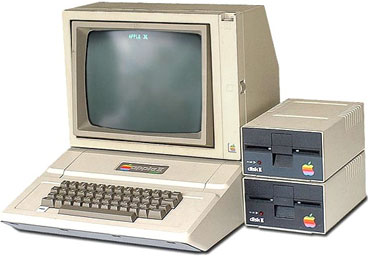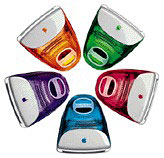As we discussed last Friday, Apple has never been a dominant player in the personal computer industry. However, that doesn’t mean it hasn’t been a significant player.
 Apple was the first to offer color on a personal computer, and the expansion bus architecture of the Apple II directly inspired IBM to offer standard expansion slots on their personal computer. Apple was the first with an affordable floppy, and their Lisa was the first personal computer with a graphical user interface and a mouse, which inspired Microsoft to create Windows.
Apple was the first to offer color on a personal computer, and the expansion bus architecture of the Apple II directly inspired IBM to offer standard expansion slots on their personal computer. Apple was the first with an affordable floppy, and their Lisa was the first personal computer with a graphical user interface and a mouse, which inspired Microsoft to create Windows.
Macs were the first desktop computers to use 3.5″ floppies, SCSI, CD-ROM drives, built-in networking, SIMMs, NuBus expansion slots, trackballs in a portable, 802.11b and 802.11g wireless networking, abandon the floppy, support DVD burning, and all sorts of other things. If you’re a longtime Mac user, you probably know the whole list.
Apple’s significance doesn’t come from its market share, which peaked at just over 20% in 1984 and has never been higher than 12% since then. According to Jeremy Reimer’s Personal Computer Market Share: 1975-2002, it’s under 3% today [this article was published in 2003].
 Time and again Apple has led the industry, whether that was to adopt 3.5″ floppies or SIMMs in the mid-80s or colorful cases in the late 1990s. And Apple has extended its influence well beyond the world of personal computers. The FireWire bus they invented shows up on all the really good digital video cameras. The iPod has taken the MP3 market by storm. And the Newton has inspired a decade of personal digital assistants.
Time and again Apple has led the industry, whether that was to adopt 3.5″ floppies or SIMMs in the mid-80s or colorful cases in the late 1990s. And Apple has extended its influence well beyond the world of personal computers. The FireWire bus they invented shows up on all the really good digital video cameras. The iPod has taken the MP3 market by storm. And the Newton has inspired a decade of personal digital assistants.
Just as the Mac’s GUI lead to Windows, Apple’s QuickTime has lead to Real Player and Windows Media Player. iTunes and iMovies have their own knockoffs on the Windows side. Shortly after the iBook shipped with AirPort, Dell decided that it also had to offer a laptop with wireless networking. Anything Apple does, the rest of the world wants to copy.
In a world of ho-hum Windows computers where brand is generally unimportant (Sony being a refreshing exception to the rule) and everything is cobbled together from a pretty standard selection of motherboards, CPUs, graphics cards, and cases, the Mac stands out. Whether colorful, white, or gray, Macs are distinctive in appearance, run a pair of unique operating systems that Windows just can’t copy, and generate the kind of brand loyalty that Gateway, Dell, and H-Paq can only dream of.
Macs are different. The Mac OS is different. The best Mac software is also different, like AppleWorks, which completely blew Microsoft Works out of the Mac market, and FileMaker and Safari, Apple’s savvy new (still in beta) browser.
Apple is a niche player because most people are content with mediocrity, don’t know that Apple really is a viable alternative, or can’t afford a recent Mac. We can’t do much about the mediocrity; we can only wait for the worst of the PC makers to bury themselves under warranty repairs and support costs.
The Switch campaign raises the Mac’s profile as an alternative to Windows PCs, although so many people still say, “Well, I’d use a Mac if I worked with graphics.” Apple does have a long ways to go to convince PC users that Macs aren’t just for DJs, students, artists, and people overly frustrated with Windows. Macs do all the “regular stuff” that Windows PCs do like email, browsing the Web, word processing, spreadsheets, and on and on.
We can try to cajole Apple into producing a truly affordable consumer Mac that could compete with the lower end of the PC world, but that’s all we can do. Until Apple realizes how much more successful the Switch campaign would be with a lower priced Mac offering Apple’s reliability at a competitive price, Apple’s niche will remain small.
Low End Mac won’t do much to increase Apple’s market share. In a world of 30 million Macs, only a quarter million visit our site in a given month. And of those, only about one-half visit more than one page or make more than a single visit.
Late 2015 update: Since switching to Intel CPUs in 2006, Apple has sold over 140 million Macs. While the Windows PC market has been in decline for years, Mac sales keep growing year after year.
Of course, we’re not generally pushing new Macs. Or maybe I should say, we’re not pushing new Macs exclusively. After all, for some people the latest models are the ones that best meet their needs.
But sometimes it’s last year’s model that provides the better value – or something even older might be the solution that best fits their budget while meeting their needs. And when someone buys a 1997 Beige G3 (one of the most popular profiles on our site), that used sale is never counted toward anybody’s market share.
But it does grow the Apple market when someone comes to the Mac, whether from the PC side or as someone buying their first computer. Once they experience the general quality of Macs (and we do try to warn them away from the handful of Road Apples) and the friendly, pretty darn stable Mac OS, we think they’ll stick with the Mac for the long haul.
And we’ll help them make the most out of their Macs, new or old, with advice on hard drive, memory, CPU, video, and other upgrades. We’ll help those who can’t afford a used$800 iMac find something they can afford and use it until it makes sense to replace it.
In a think different kind of way, a low-end consumer Mac would go contrary to our mission, since it would really impact the used Mac market and the older Macs that we know and love. On the other hand, we’d just look it over, calculate the value equation, and tell our readers how good a value the econoMac is and how they can get the most out of it in coming years.
Like Apple, Low End Mac is a niche player on the Mac Web, but having a small market doesn’t mean either of us is insignificant.
Keywords: #marketshare
Short link: http://goo.gl/WG3Vv6
searchword: #significantplayer

